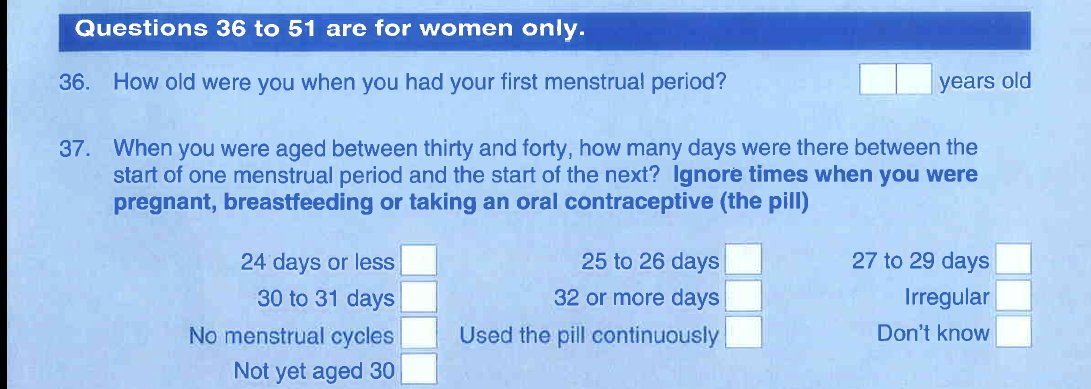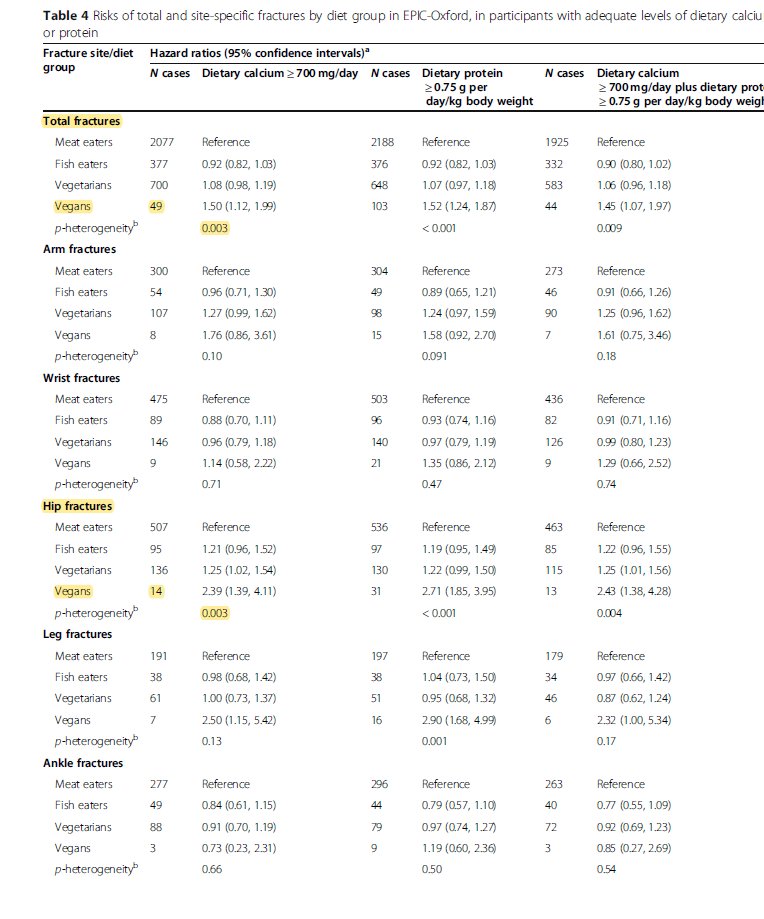
Does new study mean #vegans have weak bones? No

Does study mean you need meat for healthy bones? No

A #thread on #new study:
Vegetarian & vegan diets & risks of total & site-specific fractures: results from the prospective EPIC-Oxford study https://bmcmedicine.biomedcentral.com/articles/10.1186/s12916-020-01815-3
Main Finding:
Data showed 15 more cases of hip fracture in vegans vs meat eaters per 1000 ppl over a 10 year period
 Consider: All enrolled in the study between 1993-2001, last diet assessment 2010
Consider: All enrolled in the study between 1993-2001, last diet assessment 2010
Why it matters:
1. Much #lower knowledge about veganism 10-15-20 y ago vs today
Data showed 15 more cases of hip fracture in vegans vs meat eaters per 1000 ppl over a 10 year period
 Consider: All enrolled in the study between 1993-2001, last diet assessment 2010
Consider: All enrolled in the study between 1993-2001, last diet assessment 2010Why it matters:
1. Much #lower knowledge about veganism 10-15-20 y ago vs today
2. Less awareness re protein, RT/muscle & bone health
3. #PlantBased protein options uncommon in marketplace
Reasons for increased fractures in vegans, *important statement: "Fractures at some sites, especially at the hip, may also be more related to osteoporosis than fractures
3. #PlantBased protein options uncommon in marketplace
Reasons for increased fractures in vegans, *important statement: "Fractures at some sites, especially at the hip, may also be more related to osteoporosis than fractures
at some other sites, which might be the result of violent impacts in accidents. We were unable
to #differentiate fragility & traumatic fractures in this
study, since #data were #not #available on #causes of the fractures.
Contributing factors to Results:
1.Higher BMI=Higher BMD
to #differentiate fragility & traumatic fractures in this
study, since #data were #not #available on #causes of the fractures.
Contributing factors to Results:
1.Higher BMI=Higher BMD
2. Lower BMI (which is #protective against more serious diseases: #diabetes #CVD #cancer) has always been a risk factor for osteoporosis & fracture. Bone strength/BMD is lower in “lighter” folks since gravity forces don’t deposit as much bone mineral as it does in heavier folks
3. 24% vegans #underweight vs 8% meat eaters
4. 14% vegans #overweight vs 37% meat eaters
5. Almost 28% of females underweight: Eating Disorder #redflag. Models did not appear to adjust for amenorrhea (altho data collected) or do a subset analysis. Easily a driver for weak bones
4. 14% vegans #overweight vs 37% meat eaters
5. Almost 28% of females underweight: Eating Disorder #redflag. Models did not appear to adjust for amenorrhea (altho data collected) or do a subset analysis. Easily a driver for weak bones
Despite adjusting for BMI: 49 cases of total fractures - we dont know how many were accidents vs due to weak bones at typical fracture sites (wrist/hip) or stress fractures related to hormones, disordered eating etc (recall 28% female vegans underweight). Regardless out of 49,
the only fracture site that was significant was hip fractures. So the whole study comes down to 14 vegans having hip fractures - this is a VERY small number of ppl to base a sweeping generalization that vegans break bones more easily. We don't know details of these 14 vegans.
5. Higher BMI (meat eaters) not desirable but likely protected hips by
-Bodyfat padding
-Greater estrogen (good for BMD) from fat cells. Recall from above lack of menstrual cycle=low estrogen= weak bones
Being heavier/more muscular protects bones: importnt take home for vegans
-Bodyfat padding
-Greater estrogen (good for BMD) from fat cells. Recall from above lack of menstrual cycle=low estrogen= weak bones
Being heavier/more muscular protects bones: importnt take home for vegans
6. Parity assoc w/ higher BMD: 75% meat eaters had 1 or more children vs 34% of vegan females
7. Vegans had lowest supp use - important point since 15-20 y ago it was critical to use supps top fulfil micronutrient needs vs now 1000s of fortified plant food options in marketplace
7. Vegans had lowest supp use - important point since 15-20 y ago it was critical to use supps top fulfil micronutrient needs vs now 1000s of fortified plant food options in marketplace
Summary
Yes vegans=higher risk but.. Vegans in this study are NOT representative of vegans today. My past research was bone/stress fractures & this isnt a vegan prob but a general suboptimal diet & appropriate exerc prob (SED/excessive ex both problematic) & lifestyle prob, so:
Yes vegans=higher risk but.. Vegans in this study are NOT representative of vegans today. My past research was bone/stress fractures & this isnt a vegan prob but a general suboptimal diet & appropriate exerc prob (SED/excessive ex both problematic) & lifestyle prob, so:
Two types of groups at HIGH RISK
1. Sedentary+poor diet=weaker bones
2. Excessive exercise, lack of period, restricted eating= weaker bones
3. Non-weight bearing exercise not as helpful (cycling, swimming)
Overall I agree vegans are at greater risk but this is an easy fix:
1. Sedentary+poor diet=weaker bones
2. Excessive exercise, lack of period, restricted eating= weaker bones
3. Non-weight bearing exercise not as helpful (cycling, swimming)
Overall I agree vegans are at greater risk but this is an easy fix:
Given that bone mass declines as we age, important to engage in lifestyle activities that promote bone health. Aim to include weight-bearing exercises most days of the week, such as powerwalking, running or participating in team sports. Resistance exercise, 3 or more days per wk,
using your body weight or weights can also help strengthen your bones. Daily activities such as running up stairs, carrying heavy groceries & gardening also contribute to bone health. Also important to ensure adequate intakes of protein, calcium, vit D for optimal bone health.
Three main tips for vegans:
1. Lift weights
2. Consume more calcium
3. Consume more protein (maybe more kcal)
4. Females: maintain your period
Calcium fr FOOD:
1. Green leafy greens such as collard greens, kale
2. Soy-based products such as tofu prepared with calcium sulphate
1. Lift weights
2. Consume more calcium
3. Consume more protein (maybe more kcal)
4. Females: maintain your period
Calcium fr FOOD:
1. Green leafy greens such as collard greens, kale
2. Soy-based products such as tofu prepared with calcium sulphate
3. Legumes such as edamame, chickpeas, white beans
4. Calcium-fortified plant milks / yogurts
5. Calcium-fortified breakfast cereals
6. Sesame seeds or Tahini, Nuts especially almonds
4. Calcium-fortified plant milks / yogurts
5. Calcium-fortified breakfast cereals
6. Sesame seeds or Tahini, Nuts especially almonds
Different types of resistance training include:
1. free weights – classic strength training tools such as dumbbells, barbells, kettlebells
2. medicine balls or sand bags – weighted balls or bags
3. weight machines – devices attached either to weights or hydraulics
1. free weights – classic strength training tools such as dumbbells, barbells, kettlebells
2. medicine balls or sand bags – weighted balls or bags
3. weight machines – devices attached either to weights or hydraulics
4. resistance bands – like giant rubber bands – these provide resistance when stretched. They are portable and can be adapted to most workouts. The bands provide continuous resistance throughout a movement
5. suspension equipment – a training tool that uses gravity and the user's body weight to complete various exercises
your own body weight – can be used for squats, push-ups and chin-ups.
6. Using your own body weight is convenient, especially during pandemic!
your own body weight – can be used for squats, push-ups and chin-ups.
6. Using your own body weight is convenient, especially during pandemic!
I will likely add to my points on the study in the coming days - lots to discuss.
Remember you can be vegan and accomplish ANYTHING.
 Health
Health
 Athletics
Athletics
 Disease Prevention
Disease Prevention
 And you help Animals
And you help Animals 
 & Earth
& Earth 
Questions Welcome!
Remember you can be vegan and accomplish ANYTHING.
 Health
Health Athletics
Athletics Disease Prevention
Disease Prevention And you help Animals
And you help Animals 
 & Earth
& Earth 
Questions Welcome!

 Read on Twitter
Read on Twitter




